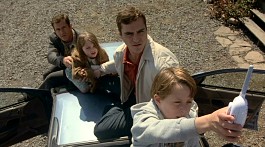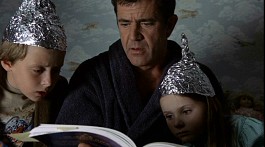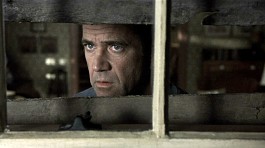 Signs appears in an aspect ratio of approximately 1.85:1 on this single-sided, dual-layered DVD; the image has been enhanced for 16X9 televisions. Though much of the movie looked fine, some problems occurred that made the picture less than stellar.
Signs appears in an aspect ratio of approximately 1.85:1 on this single-sided, dual-layered DVD; the image has been enhanced for 16X9 televisions. Though much of the movie looked fine, some problems occurred that made the picture less than stellar.
Sharpness varied but usually remained acceptable. At times, the picture seemed softer and fuzzier than I’d expect. These instances didn’t happen frequently, and they also didn’t appear major, but they popped up periodically and made the film seem less defined than normal. Neither jagged edges nor moiré effects caused concerns, some light edge enhancement seemed present at times. As for print flaws, the movie was a little grainier than normal, and I also noticed occasional examples of specks and grit.
Colors looked a bit dense at times. Parts of the movie showed a nice balance, but on other occasions, I thought the tones came across as moderately thick and muddy. For the most part, the colors were accurate and distinct, but some of these concerns did occur. Black levels seemed nicely deep and solid, but shadow detail was somewhat erratic. Most low-light shots showed appropriate definition, but a few others looked a little too dark and opaque. In the end, most of Signs looked positive, but the mix of small concerns knocked my grade down to a more average “B-“.
 The Dolby Digital 5.1 soundtrack of Signs seemed more positive. It presented a soundfield that generally emphasized the forward channels, but it opened up very well at times. The mix showed good stereo music along with a clean and accurate atmosphere from the front. Much of the time, the movie featured simple environmental audio; the low-key nature of the story didn’t require much from the surrounds, though they demonstrated solid ambience during the shots in the fields. The rear speakers really added to the film whenever the aliens became more active in the story. Those critters scampered all around the spectrum cleanly and effectively, and those elements helped make the movie creepier.
The Dolby Digital 5.1 soundtrack of Signs seemed more positive. It presented a soundfield that generally emphasized the forward channels, but it opened up very well at times. The mix showed good stereo music along with a clean and accurate atmosphere from the front. Much of the time, the movie featured simple environmental audio; the low-key nature of the story didn’t require much from the surrounds, though they demonstrated solid ambience during the shots in the fields. The rear speakers really added to the film whenever the aliens became more active in the story. Those critters scampered all around the spectrum cleanly and effectively, and those elements helped make the movie creepier.
While the film’s soundfield usually seemed somewhat subdued, the high quality of the audio made Signs work better. Dialogue always sounded natural and warm, and I noticed no issues related to intelligibility or edginess. Effects appeared lifelike and accurate, with no signs of distortion. Music presented the strongest elements of the mix, as the score appeared bright and lively, with excellent dynamics. Across the board, bass response sounded tight and deep. Ultimately, the soundtrack of Signs fell short of “A” level due to a lack of ambition, but it still worked well for the movie and also sounded great.
For this VISTA series release of Signs, we find a mix of extras. First we encounter Making Signs, a documentary split into six sections. These can be viewed as individual featurettes that last between four minutes, 48 seconds and 22 minutes, 33 seconds, or you can take them in all at once with the “Play All” option. Totaled together, the whole program lasts 58 minutes and 52 seconds. The pieces mix a few movie scenes with shots from the set and interviews. In the latter realm, we hear from writer/producer/director M. Night Shyamalan, producers Frank Marshall and Sam Mercer, executive producer Kathleen Kennedy, storyboard artist/second unit director Brick Mason, production designer Larry Fulton, visual effects supervisor Eric Brevig, composer James Newton Howard, and actors Mel Gibson, Cherry Jones, Joaquin Phoenix, Abigail Breslin and Rory Culkin.
 Overall, “Making” offers a good look at the production. It covers the film from the beginning, as Shyamalan relates his approach to new projects as well as his take on the concept and some of his influences. We then go through the visual planning for the movie, location scouting, developing the house and crop circles, and other elements. After that, we see elements that relate to specific scenes and different parts of the shoot, and we also get segments that focus on visual effects, the music, and reactions to the flick. I particularly like the parts that explore the creature effects as well as Shyamalan’s requirements for the ad campaign. The documentary seems satisfying and informative.
Overall, “Making” offers a good look at the production. It covers the film from the beginning, as Shyamalan relates his approach to new projects as well as his take on the concept and some of his influences. We then go through the visual planning for the movie, location scouting, developing the house and crop circles, and other elements. After that, we see elements that relate to specific scenes and different parts of the shoot, and we also get segments that focus on visual effects, the music, and reactions to the flick. I particularly like the parts that explore the creature effects as well as Shyamalan’s requirements for the ad campaign. The documentary seems satisfying and informative.
The Deleted Scenes area includes five clips. These rune between 21 seconds and five minutes, seven seconds for a total of seven minutes, 46 seconds of footage. Nothing particularly exciting appears here, though the single long sequence adds a little more tension of the family’s attempts to deal with the aliens.
We find a mix of options in the Multi-Angle Storyboards area. For two different scenes, you can flip between the filmed storyboards and the shots from the final film. You can also select from three different audio options: 5.1 final mix, 5.1 score only, and 5.1 effects only. The first clip – “Graham, the Knife, and the Pantry” – lasts two minutes, 58 seconds, while the other – “Graham and Merrill Chase the Unknown Trespasser” – runs two minutes, 13 seconds. The varying choices make this a nice addition to the set.
You gotta give Shyamalan one thing – he’s not afraid to have a laugh at his own expense. As with the first DVD of The Sixth Sense (but not the VISTA version) as well as Unbreakable, Signs includes a snippet of a flick taped by Shyamalan as a kid. Here we find 77 seconds of Pictures. The director provides a 60-second intro and then we watch the movie segment itself. When he denigrates the product, he ain’t kidding; this is some hilariously bad stuff, especially due to the presence of the slowest-moving alien threat ever seen. Still, it offers a fun and entertaining extra.
 In addition to a booklet that details the disc’s supplements, we find the THX Optimizer program. It purports to help you set up your home theater to best present the movie on the disc in question. Apparently the Optimizer is unique for each DVD on which it’s included; unlike programs such as Video Essentials, the Optimizer should tweak your set-up differently every time. Frankly, I’ve been very happy with my already-established calibration and I’m afraid to muck with it, so I’ve never tried the Optimizer. If you lack calibration from Video Essentials or a similar program, or if you’re just more adventurous than I, the Optimizer could be a helpful addition.
In addition to a booklet that details the disc’s supplements, we find the THX Optimizer program. It purports to help you set up your home theater to best present the movie on the disc in question. Apparently the Optimizer is unique for each DVD on which it’s included; unlike programs such as Video Essentials, the Optimizer should tweak your set-up differently every time. Frankly, I’ve been very happy with my already-established calibration and I’m afraid to muck with it, so I’ve never tried the Optimizer. If you lack calibration from Video Essentials or a similar program, or if you’re just more adventurous than I, the Optimizer could be a helpful addition.
When I saw Signs theatrically, I found it offered a pleasant surprise in that it seemed more tense and exciting than I expected. The same went for my second screening when I got the DVD. Signs held up quite well to an additional viewing, as it continued to present a taut and well-executed tale. The DVD features somewhat bland picture along with fairly solid sound and a somewhat small but reasonably interesting set of extras. Nothing about the DVD of Signs hits one out of the park, and it certainly seems like a lackluster release compared to other VISTA titles like Pearl Harbor, but the combination of generally good quality and a fine movie makes it a winner.

